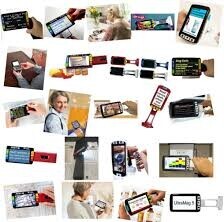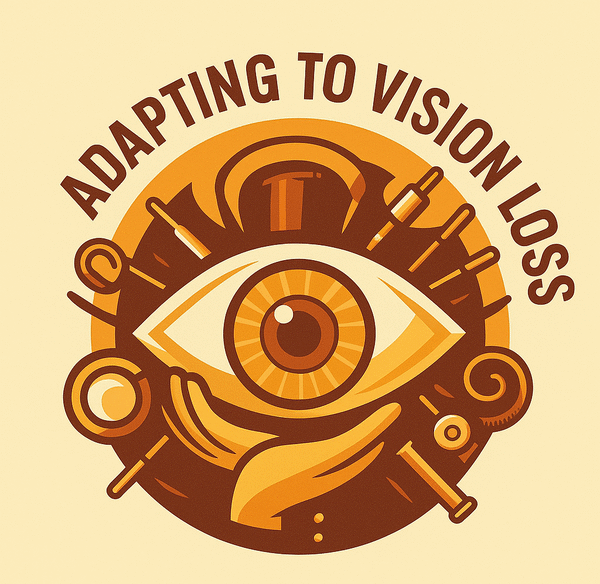When I first started losing my vision, I had no idea how many types of magnifiers were out there. I thought a magnifier was just a little round glass on a handle. Turns out, that’s just the tip of the iceberg.
Over the years, I’ve tried just about every kind of magnifierfor low vision available—from handheld models at the pharmacy to high-tech video magnifiers that cost more than my first car. Some worked beautifully, others… not so much. But each one taught me something, and I’d like to share what I’ve learned with you.
Whether you’re new to vision loss or just looking for better options, here’s a breakdown of the main categories of magnifiers, what they’re good for, and where they tend to shine (or fall short).

1. Handheld Magnifiers
These are usually the first magnifiers people try. You can find them in drugstores or order them online in every shape and size.
I started with a small handheld magnifier with a built-in light. It was helpful for quick tasks—reading a label, checking a receipt, or finding the right spice jar in the cabinet. They’re lightweight, portable, and easy to stash in a purse or pocket.
But they do have limits. The magnification often doesn’t go high enough for people with more serious vision loss, and the higher you go in strength, the smaller the viewing area becomes. You end up holding the lens so close to your face that it’s hard to keep anything in focus. That can be frustrating if you’re trying to read more than a word or two at a time.
Best for:
- Short-term tasks
- Labels, tags, or quick reading
Watch out for:
- Not enough magnification for more advanced vision loss
- Narrow field of view at higher magnification
- Can strain your hand if used for long periods
- You have to keep them at the right distance and angle, which takes practice
2. Stand Magnifiers
Stand magnifiers were a big help for me when my hands weren’t as steady. These sit flat on the reading material, giving you a consistent view without holding the lens up.
I used one for reading the mail or going through paperwork. Many have lights built in, which helps a lot in dim settings.
Best for:
- Reading at a table or desk
- Hands-free use (depending on the model)
Watch out for:
- Not great for portability
- Takes up space on a table
3. Dome and Bar Magnifiers
These are specialty magnifiers, but they can be surprisingly useful. I used a dome magnifier for newspaper headlines and a bar magnifier to keep my place when reading paragraphs of text.
They don’t require batteries or adjustments—just set them down and go.
Best for:
- Line-by-line reading
- People who want simple, optical solutions
Watch out for:
- Limited magnification strength
- Dome magnifiers can reflect overhead lights
4. Desktop Video Magnifiers (CCTV)
I’ll be honest—this one felt intimidating at first. But once I got over the learning curve, a desktop video magnifier changed the game for me. I could read long letters again, sort bills, and even work on hobbies.
These machines let you adjust zoom, contrast, and background colors, all on a large screen.
Best for:
- Extended reading or writing
- Crafting or sorting paperwork
Watch out for:
- Bulky and expensive
- Not easy to move from room to room
5. Portable Electronic Magnifiers
For me, discovering electronic magnifiers was a turning point.
My vision was getting worse, and the handhelds and stand magnifiers just weren’t cutting it anymore. I was struggling to see what I needed, even with extra lighting and higher optical strength. So when I got my first portable electronic magnifier—one with adjustable magnification and contrast—it was a real bonus. Finally, I could fine-tune what I was seeing, instead of being stuck with whatever the lens gave me.
These devices look like small tablets or cameras, and they let you zoom in on text or objects, adjust contrast, and even freeze the image so you don’t have to hold your hand steady. I used mine for reading menus, checking price tags, and reading paperwork when I wasn’t near a desktop setup.
Best for:
- On-the-go use
- Versatile daily tasks indoors and outdoors
- Adjustable contrast and magnification needs
Watch out for:
- Battery life can be a limitation
- Some models are expensive depending on features
- Small screen size on basic models can still be limiting for extended reading
6. Magnifying Apps and Accessibility Features
Before Windows came with its own magnifier, I actually used ZoomText for several years. It worked well and gave me the magnification and contrast I needed to stay productive, but like many commercial solutions, it wasn’t cheap.
Eventually, Microsoft rolled out the built-in Windows Magnifier—and for me, it was a game-changer. Suddenly, I had access to a flexible, easy-to-use magnifier right inside the operating system, without paying extra for third-party software. It has multiple modes (full-screen, lens, docked), and I can toggle it on or off with a few simple keyboard shortcuts.
And it’s not just Windows. Smartphones and tablets have joined the game, too. I regularly use the iPhone’s built-in Magnifier app, which turns the camera into a digital magnifying glass with adjustable zoom and contrast. Android has similar tools, and there are plenty of standalone magnifier apps in app stores—some of which are surprisingly powerful for everyday use.
Best for:
- Quick magnification without extra equipment
- People already using computers or smartphones
- Accessing text, documents, or signs on the go
Watch out for:
- Built-in options may not offer advanced features like ZoomText
- Can be difficult to hold a phone steady for extended use
- Varying quality depending on the device or app
7. Wearable Magnifiers and Smart Glasses
This category is growing fast. I’ve tried demo models of a few systems like IrisVision and OrCam. They offer features like text-to-speech, facial recognition, and zooming in on distant objects—all hands-free.
These devices aren’t for everyone, but they can be life-changing for some.
Best for:
- Independent navigation
- Severe vision loss where traditional magnifiers don’t cut it
Watch out for:
- High cost
- Steeper learning curve
8. Clip-On and Spectacle Magnifiers
These attach to or are built into eyeglass frames, which makes them great for hands-free work. I used them for sewing, reading recipes, and using the computer—anytime I needed both hands free.
Best for:
- Hobbies, kitchen tasks, and crafts
- People who need magnification often but don’t want to hold anything
Watch out for:
- Not ideal for mobility or reading at a distance
- May require professional fitting
Final Thoughts
Choosing the right magnifier isn’t always about finding the best one—it’s about finding the one that fits your needs right now. What worked for me in the kitchen didn’t work at the pharmacy. And what helped with reading mail wasn’t the right fit for shopping trips.
Over the next few weeks, I’ll be diving deeper into each type of magnifier in individual articles—sharing what’s worked for me, what to look for, and how to get the most out of each kind.
If you’ve tried any of these tools, I’d love to hear what worked (or didn’t) for you. Feel free to share in the comments or shoot me a message—this is a learning journey, and we’re in it together.
